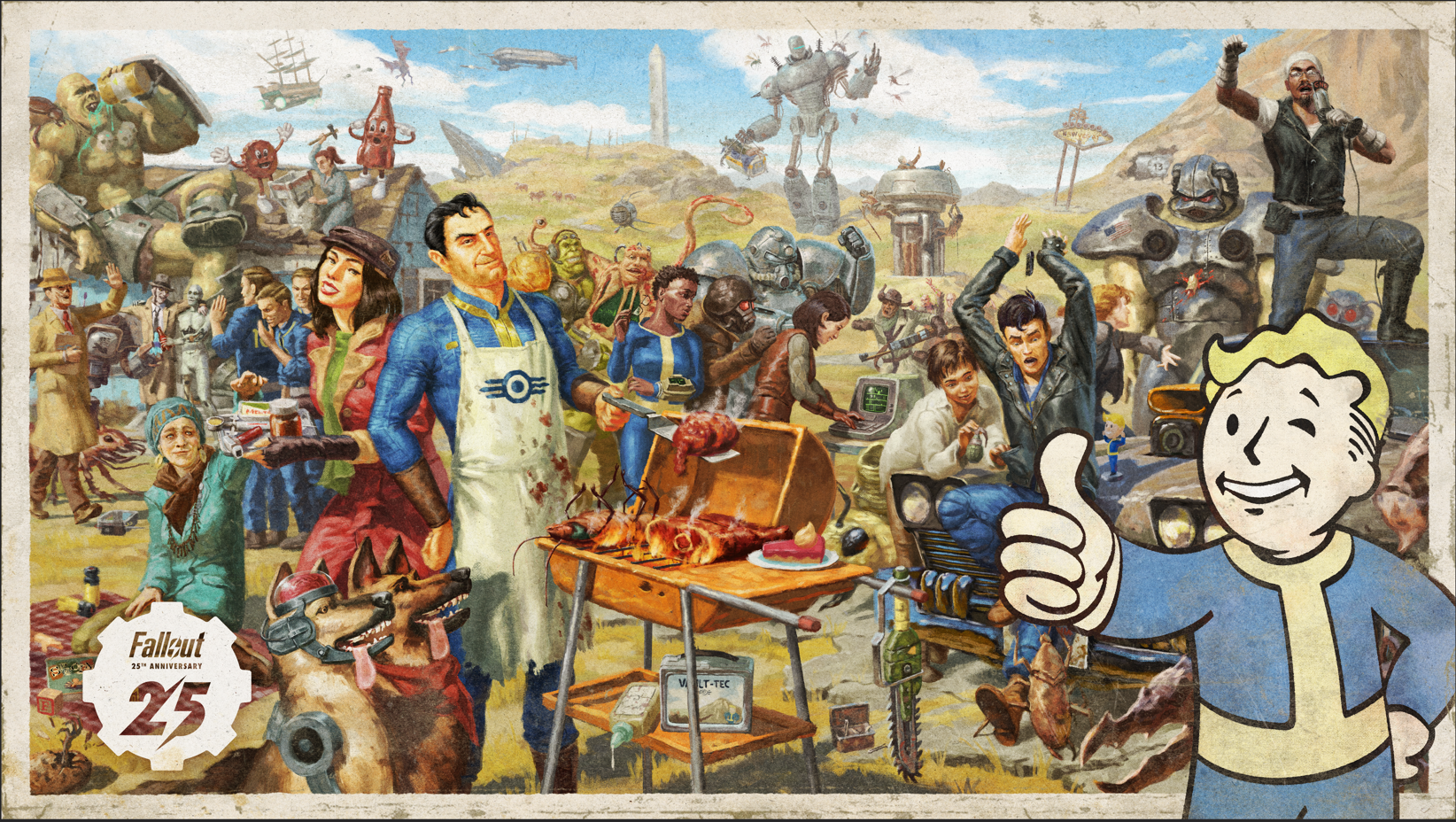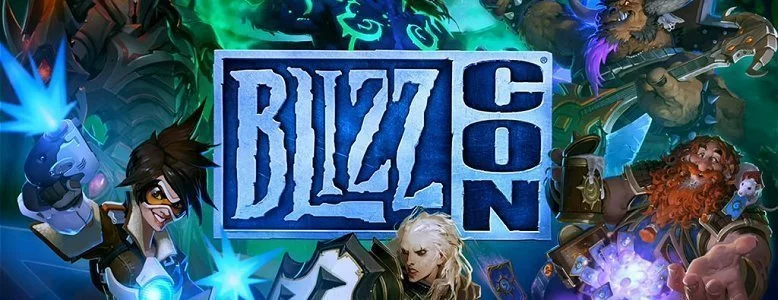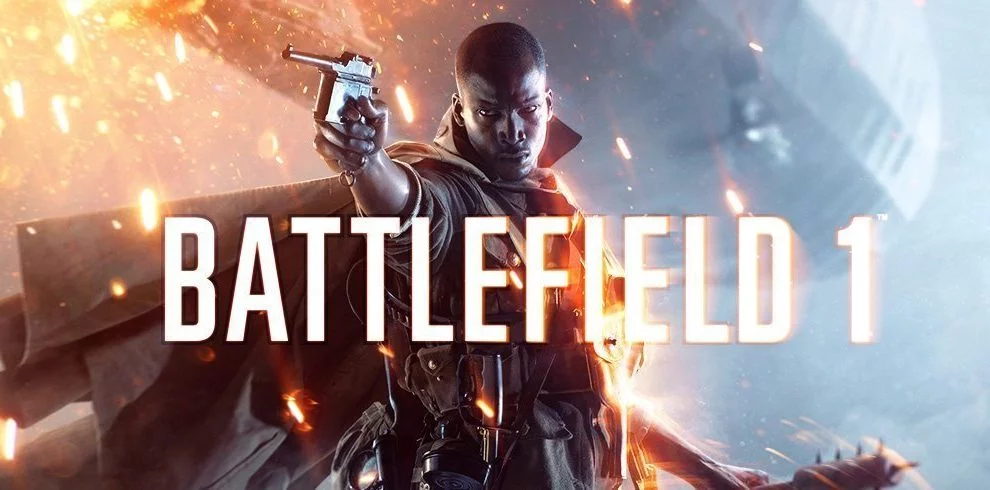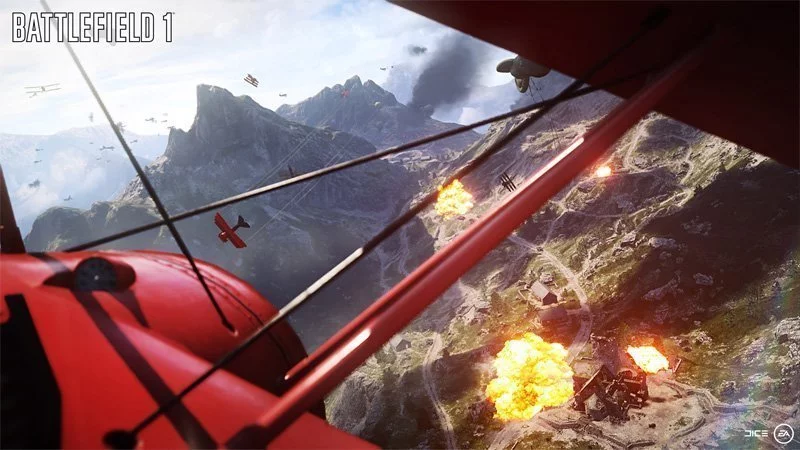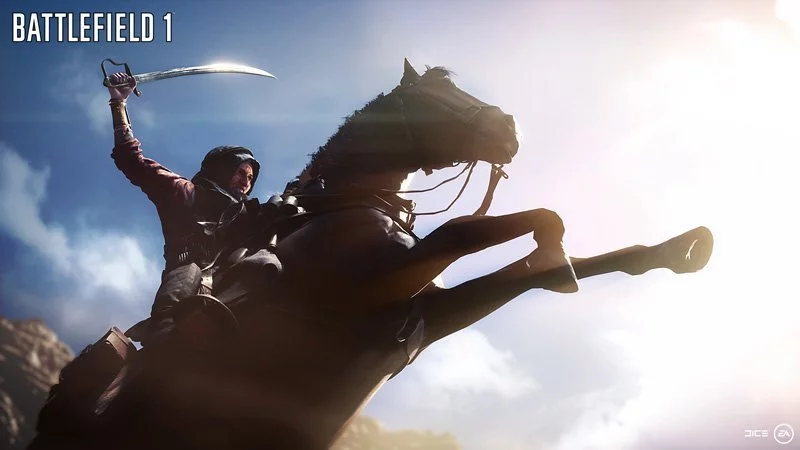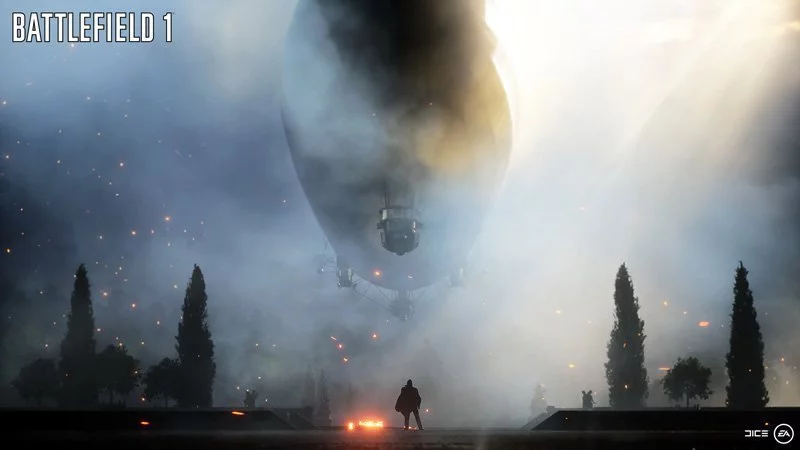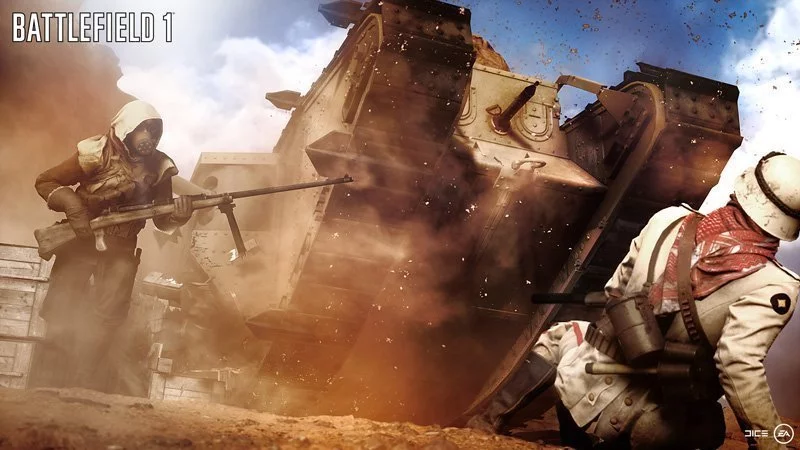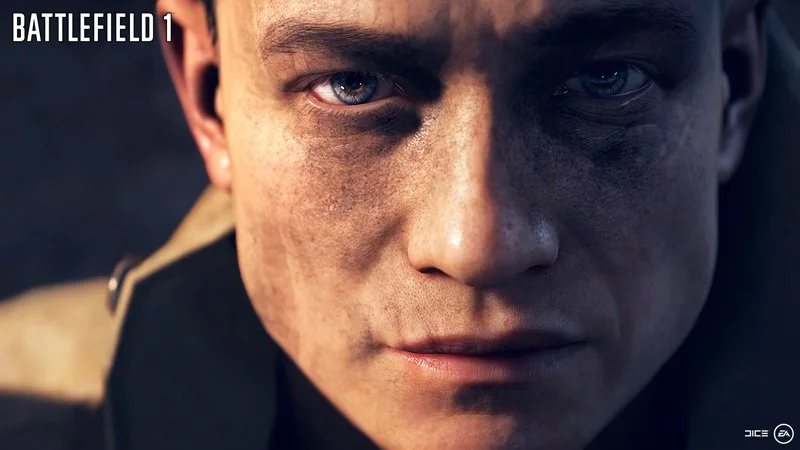Battlefield 1 is deeply respectful of shocking, horrid events that occurred more than 100 years ago and irreparably altered the course of history, surprisingly so. The headline multiplayer mode, Operations, encapsulates the essence of The Great War; the power play for territory and the desperate bids to reclaim lost ground, and injects it into a game mechanic that incites a genuine sense of achievement arising from the trials and tribulations. The War Stories single-player mode, focusing on five isolated incidents based on the true events of World War I, follows in-tow with equally insightful respect; without ever being so arrogant as to overstep the bounds of its genre or medium.
The ‘war to end war’ was the most divergent conflict the world had ever known. Bi-plane pilots bombed infantry fighting below by any means possible. Old world traditions by sword and cavalry made way for mass produced firearms and the brute force of tanks and naval destroyers. Battlefield 1 takes the appropriate liberties to combine the contrast of four years of endless innovation across diverse fronts. The weapons, vehicles and locations are courteously authentic, yet remain almost perfectly balanced on the DICE battlefield.
Battlefield earned its stripes as an industry-leading multiplayer series, later coupled with obligatory forgettable campaigns; not Battlefield 1. While it certainly won’t demand as much of your time – it took me eight hours on the hardest difficulty – the single-player offering in Battlefield 1 is every bit as good as its robust multiplayer; and if you’ve ignored the lacklustre campaigns in the past, I implore you to give it the time of day.
DICE has averted the repetition of one man’s improbable 6-hour plight by instead offering five independent missions based on the real events of World War I. It’s deeply respectful of the horrors of war, largely by putting them at the forefront. The opening prologue isn’t afraid to depict the grim reality of World War I for tens of thousands of its combatants. In fact, you’re not expected to survive the opening two minutes; and the brutally honest deaths put a name to the wasteful loss of life, and more confronting, an age.
It’s a carefully selected series of short stories that doesn’t ignore the realities of the event on which it’s based – but isn’t directly retelling. At no point did I think DICE was trying to shape my opinion on World War I. This isn’t another America versus one of the “bad nations”; true to history the yanks are barely sighted. I already had some preconceived notions, owing to the strong representation of the Allied Forces in high school history. But Battlefield 1 thoughtfully avoids demonising its enemy; we never see their side of the War Story, but the Central Powers are painted as the opposition, not the distasteful villain. It’s uncomfortably emotional in its handling of severely uncomfortable topics, but holds short of overstepping its bounds; it knows it’s still first and foremost an entertainment product and not a history lesson – but it’ll inspire you to seek further reading.
I’m almost immune to death in videogames, but Battlefield 1 made me wriggle in unrest. I say it made me feel uncomfortable, because frankly I didn’t expect a military shooter to portray such harsh reality. Dying in a blaze of glory and being relegated to a checkpoint or seeing hundreds of goons mown down by a machine gun is meaningless. But embodying a 20-year-old soldier who dies in a trench for nothing, and is forgotten just as readily, is heartbreaking. The strong emotional ties in Battlefield 1 aren’t merely a result of strong characterisation. There’s only so much it can do with such limited time to serve each protagonist – although it does an excellent job within the constraints, especially with the Australians. It’s more a combination of its gritty art style, powered by the Frostbite Engine looking sublime, the haunting sounds of war and prioritising bleak reality, over exaggerated set pieces.
The five missions are diverse in tone as much as gameplay. The EA Access offering, Through Mud and Blood, blends tank combat with tactical reconnaissance. The skies are ablaze with chaos in the dogfight plane mission, while Lawrence of Arabia’a companion Zara can choose between total stealth or an all out assault on horseback, before confronting a heavily armoured train. The variety in objectives is a given, but I was pleasantly surprised by how little shooting there is, comparatively to the recent trend of futuristic shooters. You’ll shoot a lot of men in Battlefield 1, but spend at least as much time not shooting them; and that’s the difference.
The chapter based on storming the beaches of Gallipoli has you assume the role of an Australian runner. He engages in his fair share of direct combat, but if you follow the mandate, you’re encouraged to slip passed opposing forces, as quickly as possible, and not always engage them. The Runner will be the highlight for most Australians, as a rare opportunity to feature the ANZACs. Players abroad probably won’t appreciate the gentle ribbing of the Kiwis or the competitive fury with the Poms – let alone accurate Aussie accents.
This is unequivocally the best single-player mode Battlefield has ever presented. It’s emotionally binding, it’s challenging until the final hurdle, and the episodic format does more justice to the scale of World War I than an elongated campaign ever could. Yet for all its brilliance, it’s the multiplayer where Battlefield 1 will be judged.
Operations Mode is a brilliant addition in concept and implementation. It’s the perfect middle ground between expanding the significance of the capture gameplay that dominates almost all of Battlefield’s modes, and simplifying the immediate objective. Conquest’s six points inherently divides attention, and three point Domination increases the pace with a revolving door of capturing and defence.
It’s billed separately to the other five modes (Rush, Team Deathmatch and the new War Pigeons round out the roster), for good reason. A full Operation takes around 45 minutes to complete. It’s large-scale war that gives you a defined role in attack or defence for the entire duration. In gameplay, this provides more structure for the team of 20 or 32 players on both sides. It tasks the attacking faction to capture each sector, comprising two or three control points, before moving onto the next one. There are five in total across one massive map, where success leads to attacking again on another front. That’s the end of it across three Operations – Kaiserschlackht, Conquer Hell and Iron Walls – but Oil of Empires continues on to a third map. The defenders have a marginally easier time, hoping to thwart the progression long before it comes to the last stand. They need to repel the attackers for a certain number of kills, dependent on the state of the game, to hold a sector. The attackers only get three attempts in total. After a failure, they restart at the last sector captured, with the reinforcement of a signature vehicle – an airship, armoured train or destroyer.
The concept of launching multiple offensives versus halting enemy advancement across multiple fronts is the perfect representation of World War I as a game mode. But more than that it’s the biggest advancement to Battlefield in years — certainly since it’s become a console mainstay. It’s a big time investment, and doubtlessly best played with a reliable squad, but I’ve never felt such a sense of accomplishment in an online shooter. You have to work so hard to capture or defend a single sector; it’s a genuine struggle of seesawing supremacy that evokes liberating ecstasy when you’re finally awarded the minor victory. The energising push forward quickly dissipates from something close to fierce adrenaline to the despair of victory being out of sight; it’s almost demoralising knowing that hard fought triumph will become meaningless if your team can’t do it all again, and again, and again; and yet that challenge spurs motivation.
It’s a brilliant mode — and the reason Battlefield 1’s multiplayer is magnificent — but one that requires patience and unrelenting intent. A strong kill-death ratio or high individual points have never been so meaningless; an Operation demands a persistent team commitment to the cause, especially in attack, unrivalled by any of the other objective-based modes. Conquest and Rush are similar — after all, Operations combines their core principles with grandeur. But without the scale of Operations, there’s still room for a star player to steal the show.
The other newcomer, War Pigeons, is a variant on Capture the Flag without a base. Small teams race to capture a pigeon, hold it for long enough to attach a message, and release it to deliver a message to supporting artillery to attack enemy forces; three successful messages to win. If Operations is reliant upon a strong team performance, War Pigeons is where you’ll find individual glory. Aside from eliminating or defending the player with the pigeon, kills and deaths are meaningless. It’s not the revolutionary step forward of Operations, but is a novel variant on a familiar game mode pertinent to the era.
In action, Battlefield 1 is more of the same. The War Stories set the scene for the variety of weapons and locations, and all of it makes its way into multiplayer. The weapons are mostly excellent, the land-sea-air combat loop is ideally positioned into 1918 and the maps are distinct and memorable. The contrast between tank, horse and plane is palpable, and despite the lunacy, it all works in spectacular harmony. The only thing lacking is combat by sea, as some of the maps are landlocked. Even when water is available, during our review sessions, most players seemed to ignore the sea vehicles out of lack of visibility.
Eight of Battlefield 1’s nine maps are a delight. Each has its strengths and weaknesses, and inevitably lend themselves better to certain game modes, but on the whole they’re everything we could ask for. Sinai Desert is the only obvious weak link. Perhaps a little maligned due to its overuse in the beta, it’s poorly designed for Conquest and doesn’t have the same versatility of the other options. The beaches of Fao Fortress, the corridors of Ballroom Blitz, the decrepit streets of Amiens and the chokepoint bridge of Argonne Forest offer a distinct format that keeps them feeling fresh. Destruction has returned to the levels of Bad Company — all the buildings can go down — and the behemoth vehicles make a unique impact, without totally disrupting the state of play. If there’s one thing I could change, it wouldn’t be the maps as such, but rather the vehicles. Like Battefront, air battles are hard to muster. There’s a lack of planes, perhaps due to a lack of air space, leaving them a little underutilised.
For all that I love about the performance of the old-timey weapons, Battlefield 1 has been followed by DICE’s infamous imbalance towards sniper rifles. They can overrun the larger maps, especially on the hillside of Monte Grappa, and are only really susceptible to fortified vehicles and inescapable explosions. That sounds like a fair trade, but spawning directly into the best vehicles, rather than finding all of them in the map, keeps them in annoyingly short supply.
Otherwise DICE’s rejig of the class system is strong, albeit a little unnecessary. The assault class does most of the heavy lifting, with the most accessible weapons and anti-vehicles options, which are shared by support. The medic is equipped with the former engineer’s mid-range bolt-action rifle; probably why so many early players seem to choose to play as the healer without actually healing anyone. Hot tip: you can unlock similar weapons as assault or support. If you’re going to play as a medic, remember to actually heal. The scout class rounds out the usual four, while the new pilot and tanker classes basically replace the engineer. It makes senses that spawning in a vehicle gives you to tools to repair it, but it’s hardly a monumental change.
The lingering complaint is DICE and EA’s insistence on retaining a highly lucrative but flawed DLC model. Like Battlefront, you’ll essentially need to buy Battlefield 1 twice to keep playing once the first expansion hits in March — the season pass is almost as expensive as the game. I’m not complaining about DLC, but rather its content. Adding maps and modes as downloadable content doesn’t work, it merely segregates the community. Furthermore, Dice is adding France and Russia as playable countries. Considering how respectful Battlefield 1 is otherwise, it seems strange these are paid additions. In the spirit of the rest of the game, they should be free updates.
We mostly played in controlled conditions (still online) at DICE’s office in LA. In the real world, we haven’t encountered any issues; although haven’t been able to find enough Oceanic players during the EA Access period, so had to connect to America. Quick matchmaking is true to its name, and the old school server browser should make it easier to join the exact game you want — but we haven’t really been able to test that prelaunch. Otherwise, the only technical glitch we’ve encountered is one crash on Xbox One and the occasional frame rate drop, mainly in single-player.
Battlefield 1 is the definitive Battlefield game not only of this generation, but this decade. By focusing on moments and emotional realism, rather than a continuous campaign, it’s crafted the best single-player experience of any Battlefield game, and backs it up with stellar multiplayer. Operations is the best addition in years, and the returning favourites suit the World War I theme to a tee. Now, I’m off to attempt to land a plane on the airship and take it down from the inside. That’s possible, right?
 |
|
The good
|
The bad
|
Battlefield 1 was played on PC at a review event and on Xbox One using a promotional code provided by the publisher. Stevivor attended the review event in Los Angeles. Flights and accommodation were paid for by EA. Click here to learn more about Stevivor’s scoring scale.
This article may contain affiliate links, meaning we could earn a small commission if you click-through and make a purchase. Stevivor is an independent outlet and our journalism is in no way influenced by any advertiser or commercial initiative.


